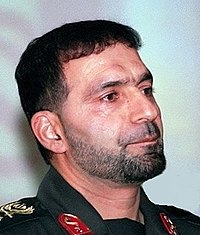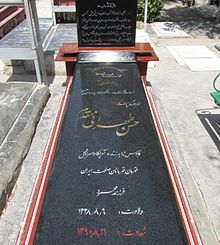| Sardar Shahid Hassan Tehrani Moghaddam | |
|---|---|
 | |
| Nickname(s) | Hassan Tehrani, Hassan Moghaddam |
| Born | 29 October 1959 Tehran, Imperial State of Iran |
| Died | 12 November 2011(2011-11-12) (aged 52) Bid Kaneh, Tehran province, Iran |
| Allegiance | Revolutionary Guards |
| Rank | Brigadier general |
| Battles / wars | Iran–Iraq War |
Hassan Tehrani Moghaddam (Persian: حسن طهرانیمقدم) (29 October 1959 – 12 November 2011) was an Iranian military officer in the IRGC Aerospace Forces and designer of Iran's ballistic missile project. He was the chief of the Army of the Guardians of the Islamic Revolutionary Guard Corps. He founded Iran's long-range missile program and sought the expertise and blueprint designs from North Korea in order to help develop Iran's missile technology. He designed the Shahab, Ghadr and Sejjil missiles with an operational range of more than 1,000–2,000 kilometres to target Israel. For these reasons he is regarded as the father of Iran's missile program. He was killed on 12 November 2011 in the Bid Kaneh explosion, at a military base belonging to the Islamic Revolutionary Guard Corps 25 miles west of Iran's capital, Tehran.
Biography
Tehrani Moghaddam was born on 29 October 1959 in Tehran. In 1977, he graduated from high school. In 1979, he received a bachelor's in Mechanical Engineering from Sharif University of Technology. In 1981, he received his MSc degree in Aerospace Engineering from K.N. Toosi University of Technology.
Moghaddam took part in the 1979 Iranian revolution. In 1980, he joined the Islamic Revolutionary Guard Corps and was given special responsibility for information in the northern section of Army of the Guardians of the Islamic Revolution. He had important roles in the Iran–Iraq War as follows:
- Establishment of the first artillery corps in IRGC in 1982
- Establishment of the artillery research center in Ahvaz in 1982
- Establishment of the missile command center in IRGC in October 1983
- Firing artillery shells towards Basrah in the Iran–Iraq War in January 1984
- Firing the first rocket towards Kirkuk in the Iran–Iraq War in February 1985
- Missile Commander of the IRGC Air Force in August 1985
- Setting up the Lebanese Hezbollah missile unit in the years 1986–87
- Designed the Naze'at missile, the first Iranian missile, in 1987
- Commanded IRGC in Operation Mersad in August 1988 against MEK forces.
Iran's missile program
After the Iran–Iraq War (1980–1988), as Iran had only non-native Scud missiles with an operational range limited to 300 kilometers, Moghaddam set up a long-range missile program and designed a number of different missiles. His immediate goal was to develop a ballistic missile program with an operational range of more than 2,000 kilometers that could hugely threaten Israel. Mostafa Izadi, a commander in the Army of the Guardians of the Islamic Revolution and close friend of Moghaddam said, "Since 1984 pioneered the IRGC's ground to ground missile system ... the work which has so frightened the world's imperialist powers and the Zionist regime today."
At first, Moghaddam designed missiles that were reverse-engineered from Russian made Scud missiles. He produced the Shahab-1 from the Scud-B, and then developed the Shahab-2 and the Zelzal missiles (Zelzal-1, Zelzal-2, and Zelzal-3). In 1998, from the Scud-C he developed the Shahab-3, which is a medium-range ballistic missile with an operational range of 2,000 kilometers. It was tested between 1998 and 2003 and was added to Iran's military arsenal on 7 July 2003, with an official unveiling by Ayatollah Khamenei on 20 July of the same year. Moghaddam later improved the Shahab-3 and developed a new version of this missile called Ghadr-110, which has a range of 1,800–2,000 kilometers and is also known as the Ghadr-101.
In 2008, Moghaddam developed and designed with the help of North Korea the first range of Iranian solid-fueled ballistic missiles known as the Sejjil. The Sejjil replaced the Shahab liquid-fueled ballistic missiles. According to US Pentagon sources, the missile profile of the Sejjil closely matches those of the Ashura (Ghadr-110) and Samen missiles. The Sejjil launch tests on 13 November 2008 displayed an operational range of 2,000–2,500 kilometers. Subsequent to this Moghaddam was the chief designer of the Shahab, Ghadr, and Sejjil missiles.
Saeed Qasemi, a commander in the Army of the Guardians of the Islamic Revolution, said that Iran owed its missile program to Moghaddam and stated: "A major part of progress in the field of missile capability was due to round-the-clock efforts by ... Moghaddam". Another commander has described Moghaddam as the founder of Iran's ballistic missile systems. Hossein Salami, the deputy head of the Islamic Revolutionary Guard Corp, declared about his role: "Moghaddam was the main architect of the IRGC' missile power and the founder of the deterrent power of our country."
Death

The Bid Kaneh arsenal explosion was a very large explosion that occurred on 12 November 2011 at the Modarres missile garrison. Seventeen members of the Army of the Guardians of the Islamic Revolution and the Islamic Revolutionary Guard Corps were killed in the incident, including Tehrani Moghaddaam. Those who died are known as the "Shahidan Ghadir".
After the explosion, initial reports indicated that it had happened at a CNG station, but this was later denied. Iranian officials said that the blast at the missile base was an accident, and ruled out any sabotage organized by the United States and its regional allies. The Army of the Guardians of the Islamic Revolution stated that the explosion "had taken place in an missile arms depot when munitions were being moved". On the Iranian parliament's news website, icana.ir, Parviz Soroori, an Iranian MP, was quoted as saying, "No sabotage was involved in this incident. It has nothing to do with politics". However, Time magazine reported claims from a "western intelligence source" that Israeli intelligence agency Mossad had orchestrated the explosion; other reports, which were also attributed to intelligence services in the West, likewise mentioned the involvement of Israel's intelligence services. An "official with close links to the Iranian Government" spoke to The Guardian anonymously and claimed that the blast was "part of the covert war against Iran, led by Israel".
Gallery
- The funeral rites of the self-sufficiency unit of AGIR with presence of Ali Khamenei
-

-

-

-

See also
References
- ^ Borger, Julian; Kamali Dehghan, Saeed (14 November 2011). "Iranian missile architect dies in blast. But was explosion a Mossad operation?". The Guardian. Retrieved 18 January 2015.
- "Iran, again: No U.S. or Israeli mischief in explosion". Los Angeles Times. 16 November 2011. Retrieved 22 January 2015.
- ^ "Iranian missile expert killed in explosion". The Guardian. 14 November 2011. Retrieved 31 December 2014.
- ^ "Introduction of AGRI missiles to threaten Zionist entity". Fars News. 15 November 2014. Archived from the original on 28 December 2014. Retrieved 28 December 2014.
- ^ "Hassan Tehrani Moghaddam Biography". hamshahrionline.ir. March 2013. Retrieved 27 December 2014.
- ^ Bar-Zohar, Michael; Mishal, Nissim (2012). Mossad the great operations of Israel's secret service. London: Robson Press. ISBN 978-1-84954-543-3.
- "Shahid Tehrani Moqadam". shakhsiatnegar.com. Archived from the original on 27 December 2014. Retrieved 27 December 2014.
- ^ "For first time, Iran media admit point of missile program was 'to hit Israel'". worldtribune.com. 8 December 2014. Archived from the original on 24 December 2014. Retrieved 31 December 2014.
- ^ "Iran Tests Second Solid-Fuelled Sejil Missile, Capable of 2, 000 km". Defense Update. 20 May 2009. Archived from the original on 5 October 2017. Retrieved 21 May 2009.
- "Iran tests new long-range missile". BBC News. 12 November 2008. Retrieved 12 November 2008.
- ^ Erdbrink, Thomas (25 November 2011). "Mysterious explosions pose dilemma for Iranian leaders". The Washington Post. Retrieved 20 January 2015.
- Staff writers (11 November 2012). "The explosion at CNG station in Alborz and Tehran is not true". Retrieved 20 January 2015.
External links
- from Tehran To Tel Aviv in 7 Minutes (The role of Tehrani Moghaddam in Iranian missile program and Lebanese Hezbollah missile unit) Archived 18 January 2015 at the Wayback Machine
- Cultural and artistic institution of Shohadae Ghadir Archived 20 January 2015 at the Wayback Machine




